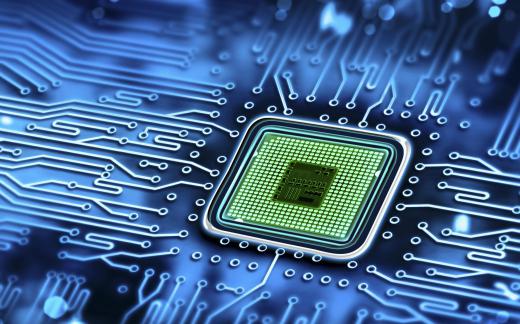What is Nanolithography?
Nanolithography is a term used to describe a number of techniques for creating incredibly small structures. The sizes involved are on the order of tens of nanometers (nm). A nanometer is a billionth of a meter, much smaller than the width of a single human hair. The word lithography is used because the method of pattern generation is essentially the same as writing, only on a much smaller scale.
One common method of nanolithography, used particularly in the creation of microchips, is known as photolithography. This technique is a parallel method of nanolithography in which the entire surface is drawn on in a single moment. Photolithography is limited in the size it can reduce to, however, because if the wavelength of light used is made too small the lens simply absorbs the light in its entirety. This means that photolithography cannot reach the super-fine sizes of some alternate technologies.

A technology that allows for smaller sizes than photolithography is that of electron-beam lithography. Using an electron beam to draw a pattern nanometer by nanometer, incredibly small sizes (on the order of 20nm) may be achieved. Electron-beam lithography is much more expensive and time consuming than photolithography, however, making it a difficult sell for industry applications of nanolithography. Since electron-beam lithography functions more like a dot-matrix printer than a flash-photograph, a job that would take five minutes using photolithography will take upwards of five hours with electron-beam lithography.
New nanolithography technologies are constantly being researched and developed, leading to smaller and smaller possible sizes. Extreme ultraviolet lithography, for example, is capable of using light at wavelengths of 13.5nm. While hurdles still exist in this new field, it promises the possibility of sizes far below those produced by current industry standards. Other nanolithography techniques include dip-pen nanolithography, in which a small tip is used to deposit molecules on a surface. Dip-pen nanolithography can achieve very small sizes, but cannot currently go below 40nm.
Funding for nanolithography research comes from a number of places, including the private academic world, futurist companies with an eye towards next-generation nanotechnology, and established computer chip manufacturers looking to shrink their chips far below their current sizes. As interest in nanotechnology grows within industrial sectors, funding and research will no doubt expand in the field of nanolithography, leading to more adept technologies and even lower limits on size.
AS FEATURED ON:
AS FEATURED ON:











Discussion Comments
@miriam98 - The fact that we can start building at the molecular level, with techniques such as dip pen lithography, has astronomical philosophical implications in my opinion.
This level of technology is bringing us closer and closer to possessing god like powers, where we can assemble matter out of virtually nothing. I realize that it’s not “nothing” – we’re just putting molecules together, but it’s still close.
I think it’s quite possible that the nanotechnology fields and genetic research fields will cross over, so that we can build mini robot organisms that emulate human life and act as little automatons with mechanical and biological processes.
I don’t think these realities could have been imagined by the greatest of science fiction writers fifty years ago.
I think nanotechnology means that semiconductor lithography will continue to produce chips that are smaller and smaller, with no perceptible end in sight.
The fact that a lot of mobile phones carry computer processing power that was once the domain strictly of desktop computers is testament to this fact. Entire operating systems and whole applications are being built for platforms on this scale.
One day I envision nanolithography will boil chip sizes down to the point where we can start wearing those legendary Dick Tracy type spy watches, which will have entire computer systems on them.
Of course you won’t have much of a display to look at, but that’s for another technology to take care of.
I want to know about the present importance of nanolithography in research areas?
Post your comments